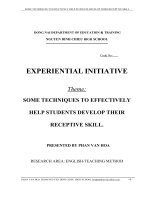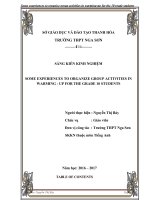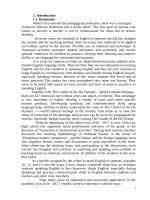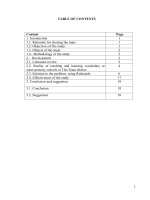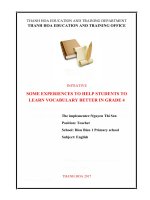Some techniques to inspire students in warming up english lessons for grade 3
Bạn đang xem bản rút gọn của tài liệu. Xem và tải ngay bản đầy đủ của tài liệu tại đây (128.11 KB, 17 trang )
A. INTRODUCTION
I. Reasons for choosing topic
In the trend of relentless integration in society today, English is used as an
international language, as a mean of communication for the whole of humanity,
and it is applied in all fields of life such as economics, politics, culture and
education ....Aware of the importance of English, in recent years, Vietnam's
education is particularly interested in teaching English in primary schools,
pupils have approached this international language early. Learning English also
helps students from the capacity to express individual ideas confidently,
independently and creatively.
However being an English teacher at a primary school, I realized: To have
a successful lesson is not easy, how to the pupils receive, love since then
actively study this subject. Once the children themselves are really passionate
learning will become easier. In the process of teaching and research, I found
that: A successful teaching hour is a combination of different elements from the
professional qualifications, social knowledge of teachers to choose the suitable
methods, equipments and teaching aids, ... and all external factors are to
promote initiative, creativity, diligence of the students in the process of
acquiring their knowledge.
To achieve that English teachers need to create comfortable friendly
learning environment to help students feel that learning a new language is really
interesting. Especially attracting more students through activity "warm-up" is
extremely important to get a successful class. So I've decided to write a
innovative experience with the subject: "Some techniques to inspire students in
warming up English lessons for grade 3".
II. The purpose of research:
"Warm-up" activities' goal is to help teachers understand the importance of
the "warm-up" and give them some "warm-up" activities.
III. Subjects of study: Students in Grade 3.
IV. Method of study:
1. Theoretical basis:
1
Read and study the materials related to children psychology, interest, the
characteristics of "warm-up" to draw evaluation.
2. Research Practice:
- Through attending English classes, observing the exchange ideas between
teachers and pupils.
- Testing the effectiveness and feasibility of the measures applied by
ourselves.
B. CONTENT
I. Theoretical bases:
In English lessons in primary schools, interest plays an extremely
important role. It helps students have the proper attitude, determine their
seriously motivation from which they will concentrate on English. This is no
easy task for teachers, in which the level of teachers is most clearly
demonstrated in guiding intellectual activities, guiding the students, thus
teachers and students have to study and work incessantly. When children are
interested in the subject they will find lessons no longer difficult or dry. The
English classes will no longer be boring for them, in addition, excitement
increases the effectiveness of cognitive process. Interest increases acting
aspirations, work capacity and personal creativity.
It can be said, passion makes people excited to work tirelessly hard,
overcome all difficulties to achieve their goals. Therefore inspire students plays
a very important role for the success of the lesson.
Although the activities account for just a very short time compared to
lesson , but they are extremely important . This is the first work done after the
teacher enter into classroom.
The activities' pedagogical aims are to be:
+ Stabilize classes, give time students to be able to adapt to new lesson.
+ Prepare psychologically, prepare knowledge.
+ Bring out excitement for a new lesson.
"Warm up" activity usually lasts 3-5 minutes and its aim is to break the
freeze in the classroom "break the ice" and reheat atmosphere up before
beginning lesson. With the above aim, planning what to do in this section, the
2
teacher should always ask the question: What is the purpose? And whether doing
that we achieve purpose or not? Thus, the activities are in all not just for fun, we
need to recognize such things are indispensable for foreign language lessons.
How to start a lesson will determine largely the result of the lesson. I have
applied these tips based on two requirements:
*. Creating a favorable environment
According to the purpose and characteristics of teaching hours, teachers
can choose the activities and tricks which suit certain aims. For example, we
will provide a pleasant atmosphere between teachers and students, elicit
initiative, self-confidence for students through the activities such as greeting,
talking, telling a joke, playing games, singing songs... to attract their attention,
stabilize classes, lead students into new lessons.
*. Psychological preparation and knowledge for new lessons
Teachers use different tricks flexibly to attract attention and inspire,
thereby students will focus on the topic of lesson.
II. Current status of the problems:
1. Current status:
a. Regarding teachers and equipments for teaching English:
Most English teachers are aware of the importance of the activities "warmup" at the beginning of class, but not all teachers can fully exploit the benefits of
this activity. Some of the teachers choose the method of check old exercises
instead of organizing activities in the beginning part because the content is too
long to teach or teachers are afraid of taking time to prepare it. Some teachers
apply a boring repetitive form.
The materials used as a reference for teaching English at primary school is
still quite modest. Besides, a lot of teachers have not been intensively trained. In
professional schools, most of them only are trained to teach English in
secondary schools and high schools. Hence, it also causes difficulties for
teachers to catch the psychology of students.
b. Regarding students:
- This is just the beginning time they get acquainted with this subject so
they feel unfamiliar. These days many students have not formed language
3
learning methods. Otherwise a significant number of students are not good at
Vietnamese.
- Students do not learn new words by heart, sentence patterns, especially
lots of students do not find joy in the subject.
2. Result and effectiveness of the current status:
After a short time I directly teach and through the survey of twenty six
grade three pupils at the beginning of 2015-2016 school year I reached the
following result:
Number
of
Point 9-10
Number
students
26
Percentag
Point 7-8
Number
e%
2
7.7
Percentag
Point 5-6
Number
e%
5
19.2
Percentag
Under point 5
Number
e%
13
50
Percentag
e%
6
23,1
III. Measures taken:
To perform a "warm up" effectively requires teachers really flexibility,
innovative, no rigidity. Within the scope of this initiative experience I just give
some simple tricks being suitable for primary students to carry out "warm up".
1. Argument/ talk with students before class:
- This form of "warm-up" is quite fast and easy to implement, we can use it
flexibly in many different cases. Topics used to chat with students are also
diverse. Before starting lesson teacher could ask general questions about health
(How are you?), weather (How's the weather? / What's the weather like today?),
ask for information about students (Who's absent today? / How old are you? /
How old is your mother? / How old is your father? / What do you do at break
time? ..... ) or simply a few words of praise, interesting comments about several
pupils (Quynh, your new shirt is very beautiful/ Tung, you look very handsome
today....).
- Occasionally teachers can start the lesson with a fairy tale, a piece of
jokes, a puzzle or tell your personal experience. Teachers can fully speak in
Vietnamese. This is creating an friendly and comfortable atmosphere before
class, strengthens collaboration between teachers and learners.
- Especially on special holidays such as Christmas, Vietnamese women's
day, Vietnamese teacher's day.... teachers need to use flexibly "warm up"
4
activities through discussing topics that help students better understand culture
and beauty of Vietnam as well as of speaking English countries. In traditional
Lunar New Year, we should give them easy and common words such as Chung
cake, peach tree ....)
2. Use pictures, illustration, real objects or actions:
2.1. Use pictures and illustrations:
Pictures will make lessons more lively, attract more students. Especially
English vocabulary of Grade 3 students is still limited, the thought-provoking
through visual bring increasingly effectiveness. Just a picture with topics related
to the content of lessons will help their students form interesting ideas.
Example: Teaching of Unit 12: This is my house. Lesson 1(1,2,3). Teachers
can bring pictures where the rooms of a house are drawn to classes, then ask for
students to describe the picture. By the way we will step into lesson quickly.
Teachers who have little artistic talent can sketch some strokes on the board
instead of bringing pictures to classes.
Teaching of Unit 19: They're in the park. Lesson2(1,2,3). Teachers come
to class and draw by chalks a few strokes showing the shower scene with a tree
swinging in the wind, the blazing sun. It is sure that all students can guess the
lesson's content.
2.2. Use the real things:
Besides the use of paintings in "warm up" activities, simply teachers can
take advantages of even real things around as an effective visual aids. Appearing
before classes with a small bag (which I and my students usually call happily is
Doremon magic cat bag), I always pay attention, arouse curiosity and
speculative minds of students. Then, when the secret is revealed about objects
inside "magic bag", the students eagerly guess lesson's content.
Example: Teaching of Unit 8: This is my pen. Lesson 1(1,2,3). I put in my
schoolbag supplies close to the students, such as pens, rulers, erasers, pencil
boxes, notebooks, pencil sharpeners ... Teaching of Unit 15: Do you have any
toys? Lesson 1.(1,2,3) I put all kinds of toys such as cars, dolls, robots, ... With
such a simple way, I quickly attracted my students in class in a natural way. But
we also need to note that we should not use real things too bulky, unhygienic or
not suitable in school.
5
2.3. Dramas:
In some specific lessons, drama is also a unique way to enter lesson.
Example: Teaching of Unit 6: Stand up. Lesson 1(1,2,3). Teachers can sit down
and stand up several times with an unusual gesture, which gives students a
wonder, attention. Then students are gradually attracted by the little dramas. The
"warm-up" activity requires teachers have performing talent.
3. Use English songs, poems, "chant":
At the age of Grade 3 students beginning to learn English, children are
excited about learning songs, poems or "chant" in English. Through teaching
fact I realize that songs, poems or chants always come easily to mind, faster any
dry grammatical structure. So in English hours teachers should teach them some
English songs which they can use in 5 minutes collective activities. Especially if
teachers select songs, poems, chant which have content close to the lesson
content, the lesson will be more effective. The programs of grade 3 English
textbook supplies a large number of songs, poems in Lesson 3(part 3).
Teachers can put this section to the top of lessons to implement the "warmup" without fear of violating the rules related to the teaching process or can ask
students to sing the song / reread copper in the next classes. To avoid monotony,
the teacher can organize a competition of group singing, vocals, performance,
reading poems, rhymes ...
Example: Teaching of Unit 2: What's your name? Lesson 2 (1,2,3). Teachers
teach students "The alphabet song," after the song I think they will guess the
lesson's content.
4. Use motive games:
- The final form of "warm-up" that I want to mention in this article is how
to warm lessons. It is difficult to do that, teachers are in need of being really
"skilled". How can teachers attract all students in their activities with stability?
This question is not easy to answer for teachers who do not have much
experience in organizing motive games. In my opinion, to limit unwanted
"noise" and "chaos" teachers should:
- Select games which are suitable for classroom layout, lesson's content and
especially time. Do not fall into the game though it really inspires students.
- Instruct quickly, neatly and clearly and all students know how to play.
6
- Actions are diverse, plentiful, highly attractive, avoid using a certain
number of games many times.
- Regularly organize active games during class to help both teachers and
students become familiar with the organization.
- Besides creating a fun atmosphere, the teacher selected games should
focus on checking the grasp of students or introduction of new content.
- Lesson 3 section 6 in new textbooks for grade 3 also offers plenty of types
of motive games, teachers can refer to manipulate. Depending on the idea, the
purpose, every teacher has different options for organizing the game. Here, I
would like to give some common games being suitable for primary students.
And I initially used "warm-up" successfully in the local school.
4.1. Simon says:
*. The general steps:
- This game is used to test remembering command phrases or sequence of
actions related to each other.
- When the management says: Simon says + command, players have to
make this order.
- When the management just say that command the player does not comply.
*. Examples in the specific unit:
- Example 1: Unit 8: This is my pen. Lesson 1(1,2,3).
Teacher's activities
Students' activities
* Warm-up:(3') Play a game: Simon
says.
- The aim of the game is to review new
words about school objects in the
previous lesson such as pen, pencil,
pencil case, school bag, notebook, pencil
sharpener.
- Explain the rule of the game:
- Listen to teacher's guide.
+ When teacher says: Simon says:
"Show me your pen," students raise their
7
pens...
+ When teacher says: Simon says:
"Show me your notebook", students raise
their notebooks...
+ If teacher only says " Show me your
pen" or " Show me your notebook",
Students don't follow teacher's guide.
- Have students play the game. Teacher
plays the role of the organizer
- Make comments and congratulate
students.
- Play the game
- Listen to teacher's
comments.
4.2. Kim's game:
*. The general steps:
- The teacher divided the class into groups.
- Teachers give students the real objects, pictures or words in a short period
of time.
- Teachers take objects, pictures or tables of words.
- The team that correctly remember more words than is the winner.
*. Examples the specific unit:
- Example: Unit17: What toys do you like? Lesson 1 (1,2,3).
Teacher's activities
* Warm-up:(5') Play the game: Kim's
game
- The aim of the game is to review new
words in the previous lesson: truck, doll,
kite, plane, robot....
- Explain the rule of the game.
- Choose four students to take part in the
game. Divide them into two teams.
- Put different kinds of toys on the desk
such as: three trucks, three dolls, three
kite, four planes......
Students' activities
- Listen to the teacher's
instruction.
- Look at and try to
remember kinds of toys and
quantities of toys.
8
- After one minute, take out toys.
- Have teams rewrite all kinds of toys
and their quantities. (one minute)
- The team which writes more correct
words will be the winners.
- Make comments and congratulate
students.
- Teams rewrite all kinds of
toys and their quantities.
Listen
comments.
to
teacher's
4.3. Pumpkin:
*. The general steps:
- Teachers identify the words that students have to know.
- Students read out the words.
- Students choose several words write the words into their notebooks.
- The teacher reads aloud the words prescribed, not in the order (students
are not known)
- Students tick the selected word to hear the teacher read them.
- Students have the words marked Bingo.
- Students shouting Bingo first is a winner.
*. Examples illustrating the specific unit:
- Example 1: Unit 2: What's your name? Lesson 1(1,2,3).
Teacher's activities
* Warm-up:(5') Play the game: Simon
says
- The aim of the game is to review the
English alphabet.
- Have students read all letters of the
English alphabet in choral
- Have students to choose 9 random
letters and write in their notebook
- Read letters not in a list (students don't
know them)
Students' activities
- Read all letters of the
English alphabet in choral
- Choose 9 random letters
and write in their notebook
- Listen and circle the letters
which teacher reads in their
notebook.
- The first student with all 9
9
- Check the result, make comments and
congratulate students.
correct letters shouts: Bingo.
- Listen to teacher 's
comments.
4.4. Brain storming:
*. The general steps:
- This is the procedure commonly used in the "warm-up" to synthesize the
information being crucial for a new unit.
- Teacher divide students into many groups. These groups will list word or
phrase under certain topics. After a specified time, the group finding more than
the other groups will be winners.
*. Examples illustrating the specific unit:
- Example 1: Unit 7: That's my school. Lesson 1 (1,2,3).
Teacher’s activities
Students’ activities
* Warm-up : (5’) Brain storming
- The aim of the game is to review
new words about school facilities .
- Divide the class into two teams.
Teams list all names of the rooms
two minutes.
- The winner is the team which lists
the names of the rooms in the
school.
gym
library
school
classroom
- Follow teacher’s guide
- Play the game in teams
playground
- Check students’ answers, make
comments and congratulate students
- Listen to teacher’s comments
4.5. Chain Game:
*. The general steps:
10
- Teachers or students start to talk about certain information.
- The second student must repeat teacher's saying or the first student's
saying and have to add other information.
- The third student must repeat the first and second person's saying and
give information more.
*. Examples illustrating specific unit:
- Example 2: Unit 10: What do you do at break time? Lesson 2 (1,2,3).
Teacher’s activities
Student’s activities
* Warm-up: (5’) Play a game: Chain game
- The aim of the game: reviewing new words
about sports and games.
- Explain the rule of the game.
- Have class play the game.
- Follow teacher’s
guide.
- St1: football
- Play the game.
- St2: football and hide-and-seek.
- St3: football, hide-and-seek and skipping.
- St4: football, hide-and-seek, skipping and
skating...
- Make comments and congratulate students.
- Listen teacher’s
comments
4.6. Chinese Whisper:
*. The general steps:
- Divide the class into vertical, vertical 8-10 per student. Each group
elected a leader
- Students standing surrender whispered a word learned with every second
student, the student must listen and speak with students standing silently next.
Done so until the last student. Students will eventually run up to say the word
again with the leader, if the word is pronounced correctly, the group is a flower,
if you mispronounce it is not a flower.
11
- After the time of the game (by teachers' regulations) group having much
cotton more than the other groups is the winning team.
*. Examples illustrate specific unit:
- Example 1: Unit 12: This is my house. Lesson 2 (1,2,3)
Teacher’s activities
* Warm-up: (5’) Play a game: Chinese Whisper
- The aim of the game: reviewing new words
about
house.
- Explain the rule of the game.
Student’s activities
- Listen to the rule of the
game
- Follow teacher’s guide.
- Divide class into three groups. Groups
stand in rows from the board to the bottom
of the class.
- Play the game in teams
- Have groups transmit following words
house, living room, kitchen, bathroom,
bedroom, dining room.
- Make comments and congratulate the winner. - Listen to teacher’s
comments
4.7. Lucky number:
*. The general steps:
- Divide the class into teams, each team has a captain.
- The teacher writes the numbers on the board, each number is
corresponding with a question, which has about 2 to 3 lucky numbers. The teams
selected number respectively. If the team that caught a lucky number will
receive a flower without answer. If the team that captured the number contains a
question correctly answer that question will receive a new flower. End of the
game, plus the total flower again. Which team is more than flowers winner.
*. Examples illustrate specific unit:
- Example 1: Unit 9: What color is it? Lesson 2(1,2,3).
Teacher’s activities
Student’s activities
* Warm-up: (5’) Play a game: Lucky number
12
- The aim of the game: reviewing new words and
sentence patterns in the previous lesson.
- Divide class into two teams.
- Follow teacher’s guide.
- Have each team choose one leader.
- Choose the leader of their
teams.
- Explain the rule of the game.
- Listen to teacher’s
instruction.
* The outsides of cards numbered from 1 to 8
1
2
3
4
5
6
7
8
9
* The insides of cards:
Lucky
number
pen/
blue
school
bags/
brown
Lucky
number
ruler/
white
Lucky
number
rubbers/gree
n
pencil
cases/
yellow
notebooks/
orange
- Have class play the game
- Make comments and congratulate the winner.
- Play the game in teams
- Listen to teacher’s
comments.
4.8. Hang Man:
*. The general steps:
- The teacher asks students to find mystery keywords.
- Students have to guess the letters in keywords.
- Every time students guess wrong, teachers draw a stick figure parts of (in
order in picture). If while the teacher complete sticks, student still can not guess
the keyword, students will lose.
13
*. Examples illustrate specific unit:
- Example: Unit 11: This is my family
Teacher’s activities
Student’s activities
* Warm-up: (5’) Play a game: Hang man
- The aim of the game: introducing the topic of
the lesson
- Explain the rule of the game.
- Listen to teacher’s
introduction.
- Have students try to guess the word family.
- Guess the letters in the
word.
- If they guess a wrong letter, draw a part of
the man. If they can’t guess the word, the man
will be hung!!!
- Introduce the topic of the lesson.
- Listen to teacher’s
introduction about the
topic of the lesson.
IV. Effectiveness
The flexible application of forms to start classes gave me the encouraging
results. The English lessons are always lively, which students are waiting for and
they actively participate in building lessons. According to the poll of students,
the majority of those polled prefer "warm-up" activities. However, students are
not consulted really made me comfortable so I often take hours thanks
colleagues for comments. My classes are always by my colleagues appreciated
and praised. Test results in every post English majority of children do all
14
satisfactory or above. Let me give you specific figures through midterm exam II
of 2015-2016 school year that I have applied the initiatives:
Number
of
Point 9-10
Number
students
26
Percentag
Point 7-8
Number
e%
6
23.1
Percentag
Point 5-6
Number
e%
11
42,3
Percentag
Under point 5
Number
e%
9
34,6
Percentag
e%
0
0
C. CONCLUSION AND PROPOSALS:
I. Conclusion:
1. Conclusion:
Folk old still has the "head down, tail fall", successful open would be a
firm basis for both teachers and students to implement following activities well.
The choice how to start is sometimes more difficult than designing a lesson
because it is difficult to create new, exciting things. The teachers have to invest
a lot of time and effort for lesson creation. So everyone knows the importance of
"warm-up". After a period of applying learning method in groups in lessons at
school I noticed that lesson is more and more vivid, the students are active in
learning, the children have engine to learn and quality has risen. Through
training, the students are more initiative, more creative, more confident, more
active work, more scientific. Students are drawn into a vivid lesson by
interesting action. And the children are more boldly than before.
2. Experience lessons:
Through this topic I draw some following experiences:
- "warm-up" is very important, it determines the success of the lesson.
- Some operations are not too long.
- Diversification of the "warm-up" helps student be not bored.
II. Recommendation:
Through the experience I strongly suggest to the leaders some following
aspirations:
1. Regarding to education and training room:
- Strengthen opening thematic workshops on changing English teaching
and learning methods.
15
- Organize extracurricular activities or English clubs for students. This
brings the opportunity for student to learn English in new way.
2. For school:
- Enhance document, reference books and teaching aids to support
teaching and learning.
3. For teachers:
- Need to define self-learning, self-training to improve their professional
knowledge and pedagogic skills. Teachers must really be responsible for their
student.
4. For students:
- Must persist in learning, to study and to learn.
Above is the solution content of "Some techniques to inspire students in
warming up English lessons for grade 3". Which I drawn in the process of
teaching. I think that this is an interesting problem in English for student in high
school and especially for pupil in primary school. Look forward to the valuable
contributions of colleagues. Besides, you may refer to the following documents:
- Teaching English ( Adrian Doff)
- How to teach English.
- Wed: Tienganh 123.com
Special thanks for your reading!
Tho Xuan, May 28th 2016
I promise that this document is mine.
Xác nhận của thủ trưởng đơn vị
I don't copy it from other.
Full name
Trần Thị Quỳnh
16
CONTENT
A. INTRODUCTION (page 1-page 2)
I. Reasons for choosing topic (page 1)
II. The purpose of research (page 1)
III. Subjects of study (page 1)
IV. Method of study (page 2)
1. Theoretical basis
2. Research Practice
B. CONTENT (page 2-page 14)
I. Theoretical bases (page 2-page3)
II. Current status of the problems (page 3-page 4)
1. Current status
2. Result and effectiveness of the current status
III. Measures taken (page 4-page 14)
1. Argument/ talk with students before class
2. Use pictures, illustration, real objects or actions
3. Use English songs, poems, "chant"
4. Use motive games
IV. Effectiveness (page 14-page 15)
C. CONCLUSION AND PROPOSALS (page 15-page 16)
I. Conclusion (page 15)
1. Conclusion
2. Experience lessons
II. Recommendation (page 15-page 16)
17

